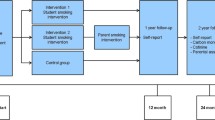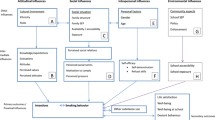Abstract
The purpose of this study was to examine Ohio parents’ perceptions of the role of schools in smoking prevention, cessation, and anti-tobacco policy for their children. A 46-item questionnaire was based on the CDC Guidelines for School Health Programs to Prevent Tobacco Use and Addiction. Surveys (n = 800) were sent to a stratified random sample of parents of junior high and high school aged students and 57% responded. Parents were supportive of smoking prevention activities, but almost two-thirds believed their child’s school should get parents’ input. Furthermore, mothers/step-mothers were more likely than fathers/step-fathers to agree that the school had a role in smoking prevention activities. The majority of parents were also supportive of smoking cessation activities. However, only 8% of parent respondents supported schools providing nicotine gum or patches to students trying to quit smoking. Overall, the majority of parents were supportive of the seven recommendations developed by the CDC as guidelines for school health programs to prevent tobacco use and addiction. Schools have the opportunity to impact student smoking through prevention and cessation activities. Schools need to know that parents are supportive of these activities and want to be included in the process of implementing effective prevention or cessation programs.

Similar content being viewed by others
References
Houston T, Kolbe LJ, Eriksen MP (1998) Tobacco-use cessation in the ‘90s–not “adults only” anymore. Prev Med 27:A1–A2
Centers for Disease Controland Prevention (1996) Projected smoking-related deaths among youth-United States. MMWR 45:971–974
Peto R, Lopez A, Boreham J, Thun M, Health C. Mortality from smoking in developing countries 1950–2000: indirect estimates from National vital statistics. Oxford University, 1994
Dozois DN, Farrow JA, Miser A (1995) Smoking patterns and cessation motivations during adolescence. Int J Addict 30:1485–1498
Everett SA, Warren CW, Sharp D, Kann L, Husten CG, Crossett LS (1999) Initiation of cigarette smoking and subsequent smoking behavior among U.S. high school students. Prev Med 29:327–333
Flint AJ, Yamada EG, Novotny TE (1998) Black–white differences in cigarette smoking uptake: progression from adolescent experimentation to regular use. Prev Med 27:358–364
Pederson LL, Lefcoe NM (1987) Short- and long-term prediction of self-reported cigarette smoking in a cohort of late adolescents: report of an 8-year follow-up of public school students. Prev Med 16:432–447
United States Department of Health and Human Services (1994) Preventing tobacco use among young people: a report of the surgeon general. US Department of Health and Human Services Public Health Service Centers for Disease Control and Prevention, National Center for Chronic Disease Prevention and Health Promotion, Office of Smoking and Health, Atlanta GA
Centers for Disease Control and Prevention. Effectiveness of school-based programs as a component of a statewide tobacco control initiative-Oregon, 1999–2000. MMWR 2001; 50: 663–666. Retrieved March 17, 2005, http://www.cdc.gov/mmwr/pdf/wk/mm5031.pdf
Noland MP, Kryscio RJ, Riggs RS, Linville LH, Ford VY, Tucker TC (1998) The effectiveness of a tobacco prevention program with adolescents living in a tobacco producing region. Am J Pub Health 88:1862–1865
Centers for Disease Control and Prevention. (2001) SHPPS 2000: the school health policies and programs study. J Sch Health. 71:249–350
Centers for Disease Control and Prevention. Cigarette sales to underage persons in Ohio for 1998. State Tobacco Activities Tracking and Evaluation System. Available at: http://www2.cdc.gov/nccdp.../non_compliance_rate. Accessed August 12, 2003
Centers for Disease Control and Prevention. Smoking attributable deaths, Ohio-1999. Tobacco Information and Prevention Source. Available at: http://www.cdc.gov/tobacco/statehi/html_2002/ohio.htm. Accessed August 12, 2003
Clark PI, Scarisbrick-Hauser A, Gautam SP, Wirk SJ (1999) Anti-tobacco socialization in homes of African-American and white parents, and smoking and nonsmoking parents. J Adolesc Health 25:329–339
Centers for Disease Control and Prevention (1994) Guidelines for school health programs to prevent tobacco use and addiction. MMWR 43(RR-2):1–18
Salant P, Dillman DA. (1994) How to Conduct Your Own Survey. John Wiley and Sons Inc., New York
King K, Pealer L, Bernard A. (2001) Increasing response rates to mail questionnaires: a review of inducement strategies. Am J Health Educ 32:4–15
Edwards P, Roberts I, Clarke M, DiGuiseppi C, Pratap S, Wentz R, Kwan I. (2002) Increasing response rates to postal questionnaires: systematic review. BMJ 324:1183–1192
Fleming CB, Kim H, Harachi TW, Catalano RF. (2002) Family processes for children in early elementary school as predictors of smoking initiation. J Adolesc Health 30:184–189
Sussman S. (2001) School-based tobacco use prevention and cessation: where are we going?. Am J Health Behav 25:191–199
Mayhew KP, Flay BR, Mott JA (2000) Stages in the development of adolescent smoking. Drug Alcohol Depend. 59(Suppl 1):S61–S81
Grunbaum JA, Kann L, Kinchen SA, Williams B, Ross JG, Lowry R, Kolbe L (2002) Youth risk behavior surveillance – United States 2001. J Sch Health. 72(8):313–328
Acknowledgment
Acknowledgment for funding of this study goes to the Ohio Tobacco Use Prevention and Control Foundation.
Author information
Authors and Affiliations
Corresponding author
Additional information
Jodi Wyman is a Research Assistant, James H. Price, Professor of Public Health, Timothy R. Jordan, Assistant Professor of Public Health, and Susan K. Telljohann, Professor of Health Education, all are affiliated to University of Toledo, Toledo, OH, USA; Joseph A. Dake is Assistant Professor of Health Education, Wayne State University, Detroit, MI, USA.
Rights and permissions
About this article
Cite this article
Wyman, J., Price, J.H., Jordan, T.R. et al. Parents’ perceptions of the role of schools in tobacco use prevention and cessation for youth. J Community Health 31, 225–248 (2006). https://doi.org/10.1007/s10900-005-9010-4
Published:
Issue Date:
DOI: https://doi.org/10.1007/s10900-005-9010-4




